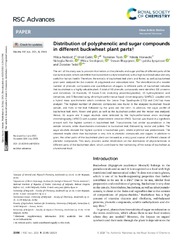Приказ основних података о документу
Distribution of polyphenolic and sugar compounds in different buckwheat plant parts
| dc.creator | Nešović, Milica | |
| dc.creator | Gašić, Uroš | |
| dc.creator | Tosti, Tomislav | |
| dc.creator | Horvacki, Nikola | |
| dc.creator | Nedić, Nebojša | |
| dc.creator | Sredojević, Milica | |
| dc.creator | Blagojević, Stevan | |
| dc.creator | Ignjatović, Ljubiša | |
| dc.creator | Tešić, Živoslav | |
| dc.date.accessioned | 2021-10-21T15:18:05Z | |
| dc.date.available | 2021-10-21T15:18:05Z | |
| dc.date.issued | 2021 | |
| dc.identifier.issn | 2046-2069 | |
| dc.identifier.uri | http://aspace.agrif.bg.ac.rs/handle/123456789/5911 | |
| dc.description.abstract | The aim of this study was to provide information on the phenolic and sugar profiles of different parts of the buckwheat plant, which can define that buckwheat is a functional food, with a high nutritional value and very useful for human health. Therefore, the extracts of buckwheat leaf, stem, and flower, as well as buckwheat grain were analysed for the content of polyphenol and antioxidant tests. The identification of a notable number of phenolic compounds and quantification of sugars in different parts of buckwheat indicates that buckwheat is a highly valuable plant. A total of 60 phenolic compounds were identified (18 cinnamic acid derivatives, 14 flavonols, 13 flavan-3-ols (including proanthocyanidins), 10 hydroxybenzoic acid derivatives, and 5 flavones) using ultra-high-performance liquid chromatography (UHPLC), coupled with a hybrid mass spectrometer which combines the Linear Trap Quadrupole (LTQ) and OrbiTrap mass analyzer. The highest number of phenolic compounds was found in the analysed buckwheat flower sample, and then in the leaf, followed by the grain and the stem. In addition, the sugar profile of buckwheat leaf, stem, flower and grain, as well as the buckwheat pollen and the nectar was analysed. Hence, 16 sugars and 5 sugar alcohols were detected by the high-performance anion exchange chromatography (HPAEC) with a pulsed amperometric detector (PAD). Sucrose was found in a significant amount with the highest content in buckwheat leaf. Trisaccharides had similar accumulation in the sample extracts, while disaccharides dominated in buckwheat leaf, followed by nectar and pollen. The sugar alcohols showed the highest content in buckwheat grain, where erythritol was predominant. The obtained results show that buckwheat is very rich in phenolic compounds and sugars. In addition to grain, the other parts of the buckwheat plant can be used as a very good source of different classes of phenolic compounds. This study provides useful information on the distribution of phytochemicals in different parts of the buckwheat plant, which contribute to the maintaining of the status of buckwheat as a functional food. | sr |
| dc.language.iso | en | sr |
| dc.publisher | Royal Society of Chemistry | sr |
| dc.relation | info:eu-repo/grantAgreement/MESTD/inst-2020/200007/RS// | sr |
| dc.relation | info:eu-repo/grantAgreement/MESTD/inst-2020/200051/RS// | sr |
| dc.relation | info:eu-repo/grantAgreement/MESTD/inst-2020/200116/RS// | sr |
| dc.relation | info:eu-repo/grantAgreement/MESTD/inst-2020/200168/RS// | sr |
| dc.relation | info:eu-repo/grantAgreement/MESTD/inst-2020/200288/RS// | sr |
| dc.rights | openAccess | sr |
| dc.rights.uri | https://creativecommons.org/licenses/by-nc/4.0/ | |
| dc.source | RSC Advances | sr |
| dc.title | Distribution of polyphenolic and sugar compounds in different buckwheat plant parts | sr |
| dc.type | article | sr |
| dc.rights.license | BY | sr |
| dc.citation.epage | 25829 | |
| dc.citation.issue | 42 | |
| dc.citation.rank | M22 | |
| dc.citation.spage | 25816 | |
| dc.citation.volume | 11 | |
| dc.identifier.doi | 10.1039/d1ra04250e | |
| dc.identifier.fulltext | http://aspace.agrif.bg.ac.rs/bitstream/id/23187/Distribution_of_polyphenolic_pub_2021.pdf | |
| dc.identifier.scopus | 2-s2.0-85111934708 | |
| dc.identifier.wos | 000680655300002 | |
| dc.type.version | publishedVersion | sr |


